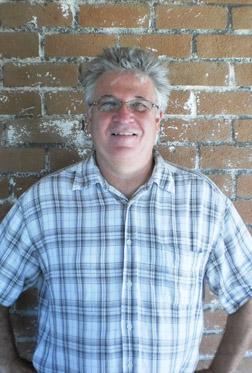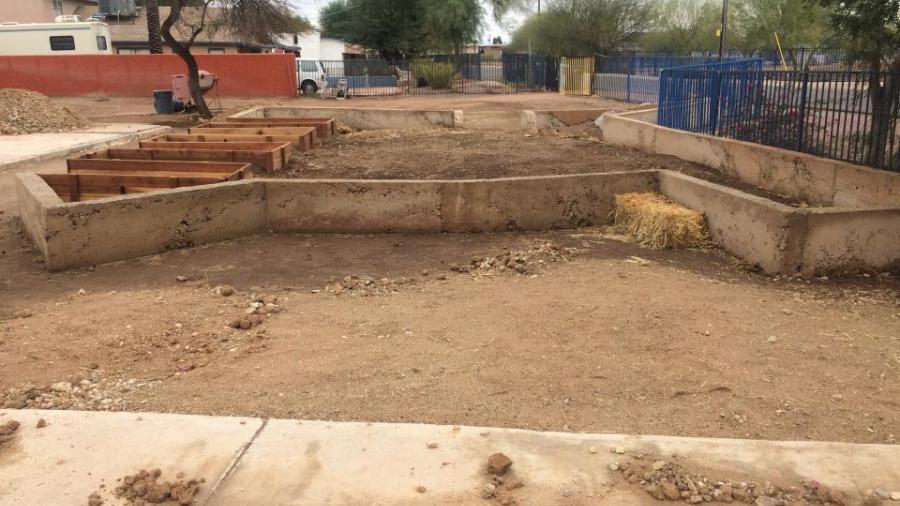Transforming Food Deserts into Food Hubs
It all started with fish.
Like many Valley of the Sun residents, ASU English PhD student Paris Masek walks his dog, bikes, and jogs along the historic canals that crisscross our cities. But unlike many of us, Masek sees possibilities that extend far beyond the steep sides of the canals and deep into culture—and the future.
Having worked for over 20 years in the aquaculture industry, Masek thinks about fish a lot. When the Salt, Gila, and Agua Fria rivers were altered for flood control, hydro-electric power, and irrigation, riparian conditions were also altered; species, such as the Colorado pike minnow, vanished. Salt River Project uses the Asian grass carp to control aquatic vegetation. “Why import a fish versus trying to restore an Indigenous fish with cultural significance to perform similar work?” asks Masek. He admits that his interests in fish biology, Indigenous cultures, and environmental issues sometimes keep him up at night.
Masek, whose dissertation on Pueblo lore challenges Westernized norms about a distinctive separation between animal and humans, has since 2011 been Agricultural Programs Director for Quincea. The nonprofit organization is a social enterprise initiative that works with Green Care Farms to provide vocational training and support for vulnerable populations, such as veterans and the developmentally disabled, so they can participate more fully in society and in life despite physical or psychological barriers. Quincea has secured over 10 acres of donated land and financial aid from public and private donors to develop green social ventures using horticultural therapy, animal assisted therapy, natural foods nutrition, and other modalities to enhance health and self-confidence.
Recently, Masek paired his extensive knowledge and experience with his passion for serving the community and formed Green on Purpose, Inc. As owner and Managing Director, he works to create vocational settings in which Quincea clients receive vocational instruction and employment; it also helps fund Quincea.
What we are trying to accomplish at Quincea and Green on Purpose does not just touch on all the communities within which they operate, but endeavors to become a laboratory to prove, revise, and then refine how to make positive and tangible changes for the future.
–Paris Masek
Green on Purpose is dedicated to serving developmentally disabled adults (Quincea members) by providing them with life and vocational skills and a better sense of self-empowerment all while working in the world of agriculture. By generating income through sales and providing services, they earn income while reducing dependence on government funding.
The Green on Purpose motto is putting food to work. Its food hub provides much needed logistical and economic support to small farmers that they could not otherwise obtain. “This is done by offering harvesting, transport, storage, handling, and sales of grown product at a greatly reduced cost for them, in addition to growing crops,” says Masek. “These tasks are staffed by Quincea members.” Green on Purpose also provides infrastructure for local farmers to help get fresh and healthy food into areas known as food deserts.
“To honor the presence of the Indigenous past in the present, we have dedicated a significant portion of our growing operations to the cultivation of Native plant species and agriculture practices,” says Masek whose farm, office, and food hub sits on an ancient Hohokam location known as Pueblo Viejo (once a Hohokam canal). “Our agriculture methods will be a mix of traditional practices and high-tech methods, such as Controlled Environment Agriculture (CEA) hydroponic lettuce production.”
Sustainability is a priority. Unused food products will be composted. Heat tolerant vegetables are preferred and transportation routes are fuel efficient. Old structures and plant materials are repurposed into components of new construction or utilized in a non-traditional manner in the facility. Water conservation is key to how Green on Purpose operates its agriculture processes.
Indigenous culture is anchored in nature. The connection of animals and narratives from the past is the thread that weaves through Masek’s scholarship and work in the community.
“In our modern world of computers, smartphones, and sub-atomic particle theories we seem to be more enamored with virtual reality than getting our hands dirty or having earth between our toes,” says Masek. “We have food deserts existing within our modern cities yet most everyone has a cell phone. The crossover to me is how to use the Indigenous knowledge that can be derived from the past—something that can be synthesized by reading and interpreting these stories then using that insight to see how one can engage in a different approach in solving food security using locally grown food. The Hohokam did it a thousand years ago. Why can’t a version of that work now?”
A common criticism of the humanities has been its focus on theoretical instead of practical knowledge, and on its perceived lack of “real-world” applicability. Masek seems able to bridge this virtual gap. “What we are trying to accomplish at Quincea and Green on Purpose does not just touch on all the communities within which they operate, but endeavors to become a laboratory to prove, revise, and then refine how to make positive and tangible changes for the future.”
Masek invites local academic institutions to join Green on Purpose in operational as well as research activities that focus on social entrepreneurship, agriculture innovation, seed saving, ethnobotany, and cultural preservation. “Within the context of Quincea and Green on Purpose,” says Masek, “we will be able to offer internships (some volunteer and some actually paid) in the near future. The possibilities are profuse.”
Masek, who also serves as a member of the Maricopa County Food System Coalition, acts as steward for Communication Committee and Food Distribution Workgroup, was Co-Chair of Phoenix Food Day, and volunteered with Liberty Wildlife for ten years. “If I have learned nothing else during my life it is not to fear what is around the corner just be prepared as best as you can.”
After he graduates with his PhD in English, Masek plans to continue on his current path—one that has led him to helping his community one seed, one fish, one head of hydroponic lettuce at a time.
Photo 1: Paris Masek. Courtesy photo.
Photo 2: Masek's truck bed full of veggies destined for the Green on Purpose farm stand. The stand offers products to the surrounding community grown by local farmers, as well as Green on Purpose. Nutritional and food preparation activities will also soon be offered at the Food Hub, as will be classes to help raise awareness and increase consumption of these preferred food products. Quincea members will also staff these operations. Photo courtesy Paris Masek
Photo 3: Raised herb beds, referred to as Pueblo Viejo Fields, after the old Hohokam village that was on the location a 1,000 years ago. The dynamics of the innovative wall construction of caliche abode material represent past cultures yet at the same time is in contrast to a high tech hydroponic production system Masek's group will have operating on the same site. It will serve the community as a place to learn how to grow, prepare, and benefit from working in the ground and eating fresh, locally grown food no matter what physical or social barriers that exist in the community. Photo courtesy Paris Masek



